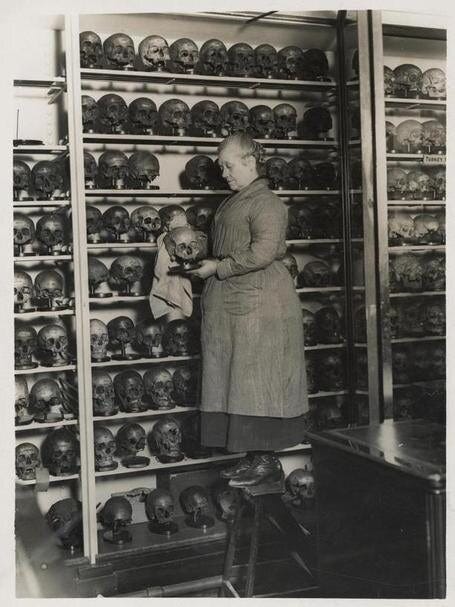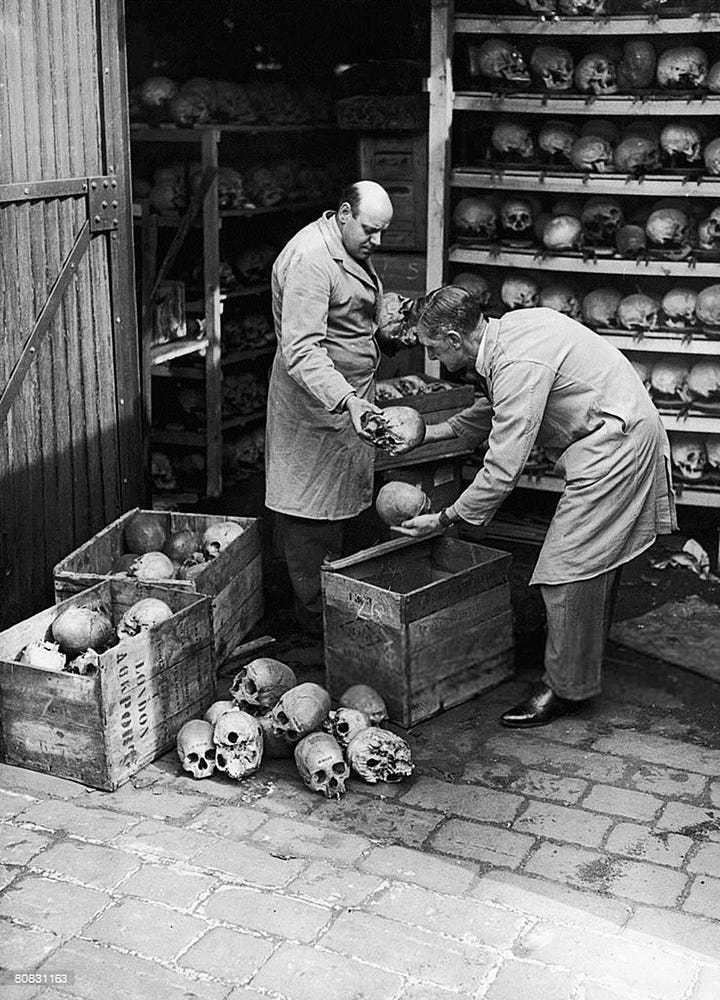A Family of Fragments: The Hunterian Museum
The time of John Hunter set the stage for the collecting impulse that was to mark the Victorian era. Armed with typology and having de-mystified the corpse, scientists were ready to categorise the 🌍.
Bird in her watery cylinder. Her head is dipped, gazing lovingly at the soft nest below filled with eggs. Twigs flutter in aqueous breeze. Her sky is pig's bladder and wax. Her neighbour is an amniotic sac, floating in its uterus like a gauzy cloud. Next door the orangutang dozes, 200 years and many more miles away from home. Eyeballs, now saturated with preserving liquid but the optic nerve still intact - are images still somewhere in the jar, briny recollections of Borneo? Above him, there's a painting of a baboon and a macaque. The former's genitals glow a fiery red like the hearth in an oil painting of peasants at home. He stretches a finger towards the top of the frame and grasps a stick in the other hand, stepping forward, propelling himself out of the darkness. Even the smallest things have been dissected and preserved. A fly split in four shows me her ovaries; they are like the finest of pearls for a fae.
For the first museum in the series, I decided to start close to home, and re-visited the newly refurbished Hunterian Museum in Lincolns Inn Fields. Housed inside the Royal College of Surgeons, the Hunterian re-opened in 2023, after 6 years and £4.6 mil of works. John Hunter’s collections have been under the loving care of the RCS for 225 years, and represent not only an invaluable medical resource, but a historic one. Hunter moved to London in 1748 to study with his brother William, a well known anatomist - showing a proclivity for dissection, he soon began work as a teaching assistant for medical students. It obsessed him, and wanting to better understand the human body in the context of the natural world, he turned to other species and “laid the foundation of his collections in comparative anatomy.” (The Illustrated Magazine of Art, 1854) He reached out to the keeper of “wild beasts” in the Tower of London for the bodies of the deceased animals, and eventually bought an estate in Earl’s Court for his dissectable menagerie. The original curation of the museum placed these fragmented bodies into categories illustrating their use:
“First, parts constituted for motion. Second, parts essential to animals respecting their own internal economy. Thirdly, parts superadded for parts concerned with external objects. And Fourthly, parts for the propagation of the species and maintenance or support of the young.” (TIMoA, 1854)
Within these categories, species were arranged in order of increasing complexity - the stomach section began with a hyatid, an animal made entirely of stomach, and ended with the ruminating stomachs of cows and goats.
The desire for classification belied a burgeoning Enlightenment interest in the possession of global knowledge. John Hunter was a contemporary of Linnaeus, the father of modern taxonomy and creator of binomial nomenclature. Most of the specimens encased in glass vials still on display today carry Latin names, like beautiful Gryllus Monstrosus.
To name is to see and immortalise, and therefore, to own. I went to a brilliant talk at the Natural History Museum last Saturday where Isabel Davies, a cultural historian, spoke about the origins of the colonial Anthropocene. The time of John Hunter and his contemporaries set the stage for the boundless collecting impulse that was to mark the Victorian era. Armed with typology and having de-mystified the corpse, colonial scientists were ready to categorise the world. In the picture taken by Timothy Le Beau of the museum from 1852, a cast of an African man wearing a loincloth stands amidst the skeletons of animals and behind the marble bust of Hunter. He is no longer on display to visitors today.


The images above show a fraction of the Hunterian’s osteopathic collection of human remains. They include the skulls of “Chinese pirates, Eskimos, and Maoris. Each of the skulls has a serial/catalog number on the forehead.” (RHP, 2021) The names of their owners in life have been long forgotten, but they carry on under new guises as members of a family of fragments, cozying up on glass shelves and in dusty crates.
Museums served as the stage for dialogues about social development and natural selection, and their curation facilitated the creation of contemporary knowledge for many scientists, writers, and politicians. Thomas Huxley, a leading biologist of the time, recognised the importance museums had to play in shaping “social traditions and environment” (Carlins, 2015), and ensured that his followers “were appointed to key positions in the new museums of ethnology and natural history” (Bennet, 2001). William Flower was the curator of the Hunterian for 3 years and its conservator for 22 - a supporter of Huxley, he provided him with material and demonstrations to bolster his position in a debate against Richard Owen about the morphology of primates’ brains. (PuLSe, 2011) By the 1800s, the role of collections had firmly shifted from aesthetic to didactic, and with this acquired world-building agency as arbiters of truth.
It is interesting that even today at the Hunterian, fragmented specimens of morbid anatomy are displayed alongside paintings and sculptures. The ‘objects d’art’ serve the same function as the medical collections, to preserve. There are paintings and busts of Hunter and other scientists, but also of a “Woman from Labrador”, a “Chinese Mandarin”, a “Polynesian”, and an “American Indian & Family”. Digging through the website I was able to find a link the archive of the complete collection of paintings owned by the Hunterian, and found even more portraits of what Hunter and his contemporaries would have found worthy of preserving the likenesses of. None of the images in the gallery below are on display to the public today, but remain in the archives of the Royal College of Surgeons.
I think there was an impulse to collect rarities out of a subconscious fear, a brewing knowledge that destructive pursuits of empire might eradicate the diversity of previously unknown places. The antidote was to immortalise in the museum, in death to save the ‘wondrous’ for the voyeurism of future generations. I think this challenge continues to face museums, and informs decisions about what fraction of a vast archive to display publicly. After the most recent renovation, the Hunterian removed from display the skeleton of Charles Byrne, a ‘giant’, due to the contentious acquisition of his remains. Byrne explicitly spoke against ending up in Hunter’s collection posthumously, and provisionally made arrangements to be shipped out of London in a sealed lead casket and buried at sea. Hunter, insatiable, hired a team to intercept Byrne’s casket on its way to Margate and brought his remains to the museum, where they remained on display until 2015. Following campaigns to return the skeleton, the Hunterian made the decision to no longer exhibit Byrne. However, I had a chat with a very knowledgeable volunteer named Peter Harrison who told me his bones remain in the private archives, as the institution believes he has more to offer science. His remains are only available for research into pituitary gigantism if a suitable, ethical case is presented to the Hunterian Collection Board of Trustees for approval. (Thank you Emily Mitchell for clarifying this!)
Museums today must toe the line between being repositories of the past, and fitting into the contemporary cultural milieu. Their role as arbiters has become more nuanced, and less powerful, with the advent of digital media and online archives. Some historians, like Peter Vergo, are concerned by the possibility of “museums becoming living fossils, unable to connect with contemporary audiences.” (Carlins, 2015). I think this worry is genuine, but overcompensated for by increasing inclusion of “interactive” displays as contextual devices. Interactivity has been for the most part narrowly defined as an exhibit which you can touch, and which is reactive, rather than static. This leads to a conflict between museums which have classic Victorian aesthetics as the bulk of their collections, and clumsily included touch screen displays or cring-ey audio. Unfortunately, the Hunterian is not exempt. Throughout the displays, audio tracks of birdsong and animal calls are heard, which feels uncanny whilst looking at their corpses in preserving fluid. Conversations between John Hunter and his brother William are also acted out over tannoy. In every room there is a plastic glowing ‘book’, illuminated by projections which I found too bright, and show images of anatomical drawings which are not on display otherwise. The result is slightly jarring, and shocks the viewer out of the pensive and reflective exercise of seeing so many fragments of bodies long dead.
I offer a potential solution, redefining ‘interactivity’, as that which focuses on the accessibility of contextual knowledge, provided in a manner which does not disrupt the process of interacting with the material objects on display. The use of colour coded labels, for instance, with a diagrammatic key, or visual timelines. The Hunterian attempts to do this, with pink panels describing some items, which inexplicably switch to green later in the collection. I’m sure there’s good reasoning for it, but the explanation is not readily accessible. Museums must continuously re-asses their public displays, but there is an important difference between freely given up-to-date context and electronic spoon feeding. Most visitors I saw ignored the digital displays, instead choosing to marvel at what they had come to the museum to see - tangible artefacts impossible to experience online. I am glad that the breadth of the displays has remained expansive, and not shied away from the potential gore-phobia of some more sensitive items. It toes a fine line between archiving the more problematic artefacts of collecting I spoke about earlier, and still remaining true to its history as an institution for medical classification and knowledge. There is a lot of nuance in appraising cultural ‘value’, and I’d be interested to know more about the process behind their curatorial decisions.
The final two rooms of the Hunterian outline the developments of 20th and 21st century medicine. Here, the walls switch to clinical white, and screens make sense, as they enmesh with the medical technologies on show seamlessly. The increased sensitivity of modern medicine towards the body and its rights are marked by a lack of posthumous remains, with machinery and examples of pills and robots taking centre stage. The individual is re-affirmed in the final room, where a film reel of extraordinary stories of surgeons plays on loop in the dark. It works.
Bibliography:
“John Hunter.” The Illustrated Magazine of Art, vol. 4, no. 22, 1854, pp. 209–11. JSTOR, http://www.jstor.org/stable/20538455. Accessed 12 Feb. 2024.
Adams, Ellen. “Defining and Displaying the Human Body: Collectors and Classics during the British Enlightenment.” Hermathena, no. 187, 2009, pp. 65–97. JSTOR, http://www.jstor.org/stable/23317524. Accessed 12 Feb. 2024.
Carlins, C. L. 2015. A Natural Curiosity: evolution in the display of natural history museums. Journal of Natural Science Collections. 2. pp. 13-21.
https://www.linnean.org/news/2022/06/29/from-the-archives-ill-let-him-know-his-place-in-nature
https://rarehistoricalphotos.com/packing-up-human-skulls-1948/
https://www.atlasobscura.com/articles/celebrating-the-hunterian-museum-bicentenary













